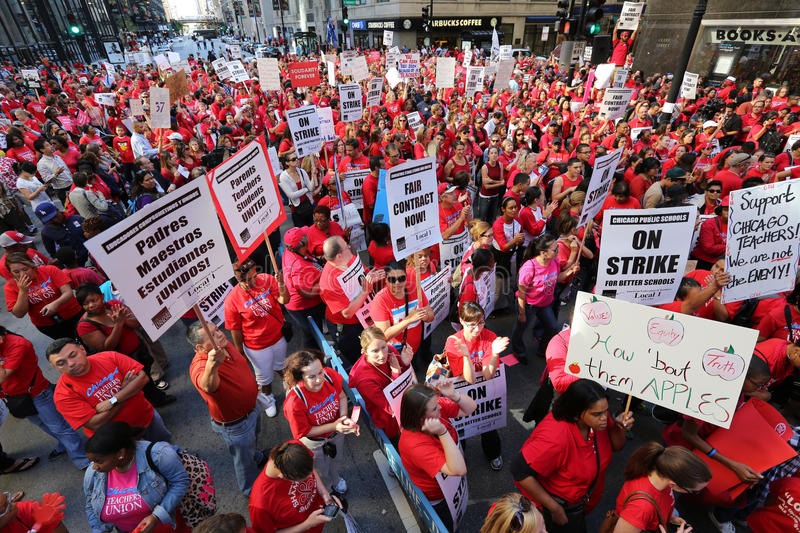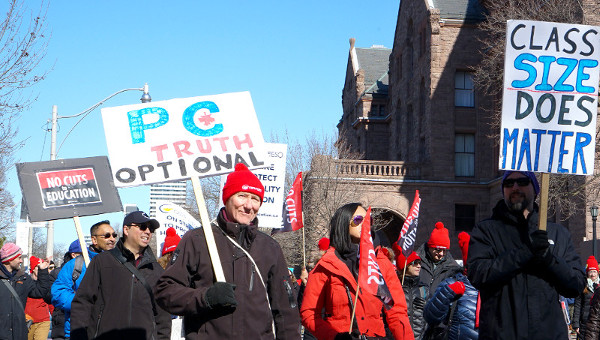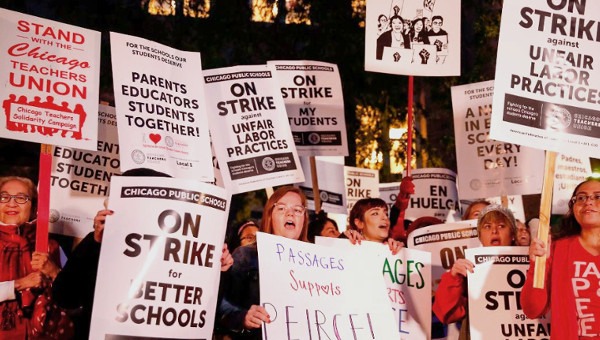On Tuesday, September 18, 2012 the Chicago Teachers Union (CTU) House of Delegates voted overwhelmingly to suspend their first strike in 25 years, begun on the previous Monday, September 10 at 12:01 am. Many commentators from both left alternative publications and in the corporate press have observed that in an era of austerity when seemingly no unions in the United States – and I would add Canada – are fighting back against layoffs, budget cuts, wage freezes and the like, the CTU has stood up to a city government that was seeking massive concessions. Many of these concessions, from merit pay and teacher evaluations based on standardized tests, have been central to the dismantling of public education that has been advanced by political and economic elites like the Commercial Club of Chicago, the Bill and Melinda Gates Foundation, and the Walton Foundation under the guise of “education reform.” As CTU president Karen Lewis noted on more than one occasion, this strike was part of a wider battle over the soul of public education. I would add that it has also been a testing ground for an alternative strategy, movement oriented strategy for the North American labour movement.
While the members of the union still need to vote on whether or not to ratify the tentative agreement negotiated over the weekend, which was examined and discussed by members on the picket lines Monday and Tuesday, it is likely to be ratified within the next two weeks.
So, now that the strike is over, what did it mean for both the city of Chicago and for the U.S. labour movement?
A Resounding Victory
First, because education and the attack on teachers and their unions has been at the forefront of class struggle in the United States and around the world any analysis of the CTU strike needs to begin with an acknowledgement of it as a resounding victory for working people, for unions and for the fight to defend and perhaps more importantly transform public education.


This strike pushed the boundaries of contract unionism and took a moment in which the teachers union in Chicago was battling concessions and a mayor, Rahm Emanuel, who was intent on further eroding the power of the union and advancing a billionaire backed “education reform” agenda even further and turned it into a movement to fight for an improved education system and more broadly to fight for a city that puts people ahead of profit. It has been a long time since people have seen a union, in the public or the private sector, use the most powerful weapon in the arsenal of labour, the strike, to fight back.
The strike has successfully galvanized not just the members of the CTU, which represents approximately 29,000 teachers, paraprofessionals (PSRPs), nurses, social workers and clinicians, but for a brief moment ignited a fire in the working-class and poor communities of Chicago – one supported and fanned even by the fire fighters union in Chicago! As middle school teacher and CTU organizer Brandon Johnson observed, “the CTU put more people on the streets then the Cubs did all summer.”
People in every neighbourhood in the city showed their active support of the teachers by coming out to the picket lines, bringing with them food, coffee and warm encouragement, turning out in large numbers to the mass mobilizations that took place each day of the strike, or just blasting their car horns and cheering whenever they saw people wearing the red t-shirts of the teachers union (or really any folks wearing red who may not have been doing so in solidarity with the teachers, at least intentionally).
“I’m extremely proud of this union’s leadership,” said Rory Fanning, a local activist involved with Communities United Against Foreclosures and Evictions. “They got major concessions only because 30,000 people took to the street. [Reagan firing the air traffic controllers] instilled fear in other unions who wanted to do the same thing. What this teachers union is doing is giving other unions confidence, inspiring other unions to re-evaluate their leadership put them on notice that they better start acknowledging the will of the rank and file.” (Quoted in a Chicago Sun-Times editorial, 19/09/12.)
While far from securing everything that the CTU and their allies were fighting for in this round of negotiations the union has managed to beat back some of the most egregious concessionary proposals that were being pushed by the Mayor (Rahm Emanuel) and the negotiating team on the Board of Education. Chief amongst these was a merit pay scheme that was tied to what is called “value added” metrics derived from the annual improvement in student performance on standardized test scores and the removal of “step and lane” pay increases that are based on a teachers experience in the classroom and attainment of advanced degrees. Losing on these proposals is a major set back for wider efforts to deprofessionalize teachers and create a more “flexible” teaching workforce.
Community Support
The biggest lesson for labour, especially public sector unions, is that reaching out to the public for support is all well and good but really winning their support requires that you make your struggle their struggle by fighting on broader class and antiracist terms. It has been vital for the CTU to cast their battle as one that is over the very future of public education and to make it clear that their fight is not simply for improvements to salary and working conditions but is fundamentally about creating good neighborhood schools where all kids have access to a rich curriculum that includes art, music, physical education and world languages, small classes and the social services that the most disadvantaged students so desperately need. In making the contract fight a component of a larger struggle against the corporatization of public schools aimed at securing the “Schools that Chicago Students Deserve” the union needed to first expose the school system that it is a part of as a major component of a new form of racial apartheid in the city that has been designed to contain the poorest, largely African-American and Latino, students. In doing this the CTU has provided public sector unions with a new model of resistance and unionism.
The corporate-backed advocates of charter schools and vouchers have for years framed their “school choice” movement in these terms, the difference being that they do so within highly individualized terms that puts all of the blame for student failure (based on the narrow metrics of standardized tests) on “bad teachers” and the despicable unions that protect them. Thus, coming to grips with the actual problems in the public institutions that we work in and putting forward transformative, research-backed solutions for fixing them is crucial for winning in this period of austerity.
Partial Victories
Two important issues that were at the center of the strike can only been seen as partial wins for the teachers. The first is the new evaluation system, which will have 30 per cent of its weight tied to standardized test scores, rather than the 45 per cent that the Board was demanding. The union will also be able to grieve evaluations, which is something the Board had been refusing to budge on. Some of the major flaws with this evaluation system, however, is that if a teacher receives a low rating they will not have seniority protection in the event of layoffs.
The second area that is intimately connected to Rahm Emanuel’s desire to expand charter schools and push out the more experienced teachers – and thus financially more costly – is previously non-existent recall language that requires the Board to rehire laid off teachers and on the new teacher evaluation system. Previously seniority for teachers only existed at the school level.
Yet another important area that the union failed to win any ground on – and which according to Illinois state law is not something that the Board is required to negotiate over – is class size. Chicago is the only school district in Illinois where a union cannot negotiate or strike over class size. As Theresa Moran of Labor Notes (19/09/12) reports, “The contract does little to address class size – preserving toothless policies that have allowed classrooms to balloon to 40 or 50 kids despite caps of 35.” One good note here is that a panel to monitor class size will receive additional funds and now include a parent.
Transform and Revitalize
Prior to the rise of the Caucus of Rank and File Educators (CORE), which is the progressive reform caucus of CTU members and allies that won the leadership of the union in 2010, the CTU had, like many other teacher unions across the country been quite complicit with many of the corporate education reforms that were enacted since the early 1990s, including the restructuring of school governance along a corporate model (mayoral control) and the expansion of charter schools.
As George Schmidt, long time CTU activist and founding editor of the newspaper focused on education and Chicago politics Substance, has observed the 1990s under the leadership of Tom Reese and then Marilyn Steward was a bleak period for the CTU, with it devolved into a “company union” that lacked both the will and know-how to mobilize the ranks to take on the assault on public education, teachers and their unions.
The story behind how CORE managed to so completely transform and revitalize the CTU over the course of the past four years is a critical one but beyond the scope of this article. Yet I do want to highlight a few of the most important dimensions of why CORE has been so effective in transforming the union and producing such an important victory for teachers, students and the working-class in Chicago and the United States more broadly.
“Their commitment to a broader vision of grassroots, social justice unionism that builds genuinely reciprocal alliances with neighbourhood and city-wide community organizations, parents and students while at the same time building power at the workplace is a lesson for workers in both the private and public sectors.”
Firstly, their commitment to building rank and file power and leadership at multiple scales – from neighbourhood schools to the negotiating table and the ways in which the rank and file was kept informed and engaged through negotiations and the strike was pivotal. Secondly, their commitment to a broader vision of grassroots, social justice unionism that builds genuinely reciprocal alliances with neighbourhood and city-wide community organizations, parents and students while at the same time building power at the workplace is a lesson for workers in both the private and public sectors. And thirdly, CORE’s continued existence and development as an organization committed to recruiting, mobilizing and developing the capacity of CTU members, rather than being a traditional union reform caucus that runs a slate, gets them elected and disappears until the next election has been a departure from other union reform experiences. CORE has showed us the importance of maintaining a caucus that retains and builds its capacity as an independent organizing force within the union that can be both supportive of the leadership that came out of their caucus and also be critical of their decisions and work when necessary.
As a union, as a membership – at individual schools and across the city of Chicago – teachers and support staff are more unified and mobilized as a result of the strike. As one CTU delegate Beverely Allebach told The Real News Network after Tuesday’s Delegate Assembly meeting, “We are in this fight for public education like never before. And our goal is to stop the privatizing of our schools…we are in this for the long haul, for all of our children, not just for some of our children.”
Another teacher and union delegate at Curie High School, Adam Heenan said that he thought that CTU members could go back into the classroom with dignity now, even though they did not win as much as they had hoped. The lesson from Chicago, Heenan pointed out is that “with an organizing model of unionism instead of a service model we can take back our public schools.”
And as Brandon Johnson pointed out a day after CTU delegates decided to suspend the strike, “It’s not over Chicago, it’s getting bigger.” •
Peter Brogan is a PhD candidate and Teaching Assistant in Geography at York University. He is just back from Chicago where he has spent the past six months doing research on the role that education restructuring and teacher unions have been playing in the making of global cities and contemporary capitalism.





